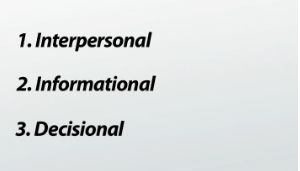Henry Mintzberg's Managerial Roles
After you watch the video and know the material, click HERE for the quiz.
There are many roles a manager has within an organization. Henry Mintzberg describes ten specific managerial roles most commonly seen within organizations. This lesson will discuss each of these roles and what behaviors are associated with them.
Henry Mintzberg's Managerial Roles
There are many roles a manager has within an organization. Performing these roles is the basis of a manager's job. To be effective at these roles, a manger must be a complete businessperson by understanding the strategic, tactical and operational responsibilities he or she holds. While not always explicitly stated in a manager's job description, at any given moment a manager might have to be a coach, a strategic planner, a liaison, a cheerleader, a conflict manager, a realist, a problem-solver, an organizer, an optimist, a trainer and a decision-maker. These roles can change from day to day, but one thing is for sure: a manager must understand all of his or her roles and how to perform them effectively. This means that a manager must have a global understanding of all business functions, organizational goals, his or her level of accountability and the appropriate way to serve both internal and external clients of the organization.
 |
Henry Mintzberg spent much of his career researching the managerial roles and behaviors of several chief executive officers, or CEOs. Mintzberg discovered that managers spent most of their time engaging in ten specific roles. He was able to then classify these roles into three categories, including interpersonal, informational and decisional roles. To better understand these roles, let's look at how they are applied by Bernard the Boss as he goes through his daily routine as a manager at a local grocery store.
 |
Interpersonal Roles
The first category of roles described by Mintzberg is called interpersonal roles. These roles involve the behaviors associated with human interaction. In other words, interpersonal roles are those roles that allow a manager to interact with his or her employees for the purpose of achieving organizational goals. There are three roles listed under interpersonal roles, which include figurehead, leader and liaison. Let's look at how these three roles are played out by Bernard.
When Bernard arrives at the store in the morning, he holds a daily meeting for all employees who are working that day. He spends time talking about daily specials and sales goals and motivates his employees for the day by holding a friendly contest between the workers to try to sell as many of the sale items as possible during their shift. He informs his employees that the highest seller will win a $50 gift certificate for the store. As a figurehead, Bernard the Boss has certain social, ceremonial and legal responsibilities that his employees expect him to fulfill. Bernard is seen as a source of inspiration and authority to his employees.
 |
As Bernard goes about his day, he must make sure that he's monitoring the performance of his employees and how well they are doing in their sales. He checks with his employees periodically to make sure they understand the products that are on sale and what key features to point out, as well as to remind them of their goal of winning the contest. Bernard the Boss's role as a leader requires him to direct and manage the performance of his employees. He will spend time communicating performance goals, training and mentoring employees, supporting employee efforts, supplying resources, evaluating employee performance and motivating employees toward a higher level of productivity.
Bernard does not leave all the selling up to his employees, because he likes to maintain contact with his customers to better understand their needs and how he can accommodate them. He stops and chats with several customers throughout the day to get feedback on sale items and to learn about products that his customers would like to see the store put on sale in the future. Acting as a liaison is Bernard the Boss's final interpersonal role. As a liaison, Bernard communicates with internal and external members of the organization. This networking activity is a critical step in reaching organizational goals, especially those concerned with customers.
Informational Roles
The second category of managerial roles is informational roles. The informational roles include those roles in which a manager must generate and share knowledge to successfully achieve organizational goals. There are three roles listed under informational roles, which include monitor, disseminator and spokesperson.
After Bernard is comfortable with his employees' understanding of the sales products and their goals, he heads back to his office to do some research for what he will put on sale next week. Bernard spends time reflecting on the feedback his employees gave and the information his customers shared with him that day, and he also looks at what his competitors are putting on sale at this time. The monitor role that Bernard the Boss must fill involves the task of researching, locating and choosing useful information. As a monitor, Bernard has to stay abreast to current industry standards and changes occurring in both the internal and external business environments. This also includes monitoring the performance of employees and their level of productivity.
 |
Now that Bernard has approval from upper management, he creates the advertisement for next week's sale items and begins to distribute it to his customers. Acting as a spokesperson on behalf of the organization is Bernard's final informational role. As a spokesperson, Bernard communicates information about the organization to outside parties.
Decisional Roles
The third category of managerial roles according to Mintzberg is called decisional roles. Decisional roles include roles such as the entrepreneur, disturbance-handler, resource-allocator and negotiator. All of these roles involve the process of using information to make decisions.
Bernard checks in with his employees at midday and notices that some of the sale items have not done as well as anticipated. After speaking with his employees, he learns that the items that have not been selling are sitting next to the generic brand on the shelves. These generic brands are still less expensive than the sale items and are causing customers to choose the less expensive version. Bernard makes the decision to move these items to a special display area where they can sit by themselves and hopefully attract more buyers. As an entrepreneur, Bernard the Boss is focused on process improvement. He looks for ways to improve productivity and efficiency within his organization and directs the change process from development to implementation.
 |
As Bernard is setting up the display, he notices two of his employees arguing over the contest, and he is not the only one. Customers have also noticed, and some are starting to even leave the store. Bernard quickly intervenes and helps to bring the employees to an agreement. Acting as a disturbance-handler, Bernard serves as a conflict manager. He spends time taking corrective action during times of dispute to remove any barriers toward organizational success.
After the display is set up, Bernard heads back to his office and sees that he has a voicemail. After checking the voicemail, he learns that one of his employees who works the night shift has called out sick. He needs to cover that shift and quickly begins to ask employees who are currently working if they would mind working a double shift. He finds a replacement and is then able to go back to his daily responsibilities. Determining the best place for organizational resources to be distributed is what Bernard does in his role as a resource-allocator. Taking the time to plan, dispense and monitor resources is essential for Bernard to ensure that his employees continue to be productive.
Bernard the Boss ends his shift with a conference call with one of his distributors. He learns that the store will now be charged an additional $300 for each delivery. Bernard knows that he has to adhere to a set budget that was based on the old delivery fees. He spends some time negotiating with the distributor and comes to a compromise that the additional fee will not be charged until next quarter, when he can account for it in the budget. The negotiator role is the last of the decisional roles that Bernard must fill. As a negotiator, Bernard acts as a representative for the team, department or organization during times of negotiation, whereby he looks out for the best interests of the party he represents.
 |
Mintzberg's Managerial Roles Today
Even though Mintzberg's research was conducted many years ago, his discoveries of the ten managerial roles are still seen in business today. Managers of all levels perform the roles described by Mintzberg on a daily basis at organizations worldwide. Many managers assess their own behaviors against those described by Mintzberg to become more self-aware of how they can improve their managerial practices.
Lesson Summary
There are many roles a manager has within an organization. Henry Mintzberg described ten specific managerial roles most commonly seen within organizations. Mintzberg classified the roles into three categories: interpersonal roles, or those roles associated with human interaction; informational roles, or those roles associated with sharing information and decisional roles, or those roles involved in decision-making. Interpersonal roles include the figurehead, leader and liaison. Informational roles include the monitor, disseminator and spokesperson. Decisional roles include the entrepreneur, disturbance-handler, resource-allocator and negotiator.